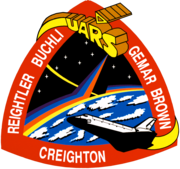STS-48

The UARS satellite in Discovery's payload bay
|
|
| Mission type | Satellite deployment |
|---|---|
| Operator | NASA |
| COSPAR ID | 1991-063A |
| SATCAT № | 21700 |
| Mission duration | 5 days, 8 hours, 27 minutes, 38 seconds |
| Distance travelled | 3,530,369 kilometers (2,193,670 mi) |
| Orbits completed | 81 |
| Spacecraft properties | |
| Spacecraft | Space Shuttle Discovery |
| Launch mass | 240,062 pounds (108,890 kg) |
| Landing mass | 87,321 kilograms (192,510 lb) |
| Payload mass | 7,865 kilograms (17,339 lb) |
| Crew | |
| Crew size | 5 |
| Members |
John O. Creighton Kenneth S. Reightler, Jr. Charles D. Gemar James F. Buchli Mark N. Brown |
| Start of mission | |
| Launch date | 12 September 1991, 23:11:04 UTC |
| Launch site | Kennedy LC-39A |
| End of mission | |
| Landing date | 18 September 1991, 07:38:42 UTC |
| Landing site | Edwards Runway 22 |
| Orbital parameters | |
| Reference system | Geocentric |
| Regime | Low Earth |
| Perigee | 575 kilometres (357 mi) |
| Apogee | 580 kilometres (360 mi) |
| Inclination | 57.0 degrees |
| Period | 96.2 minutes |
 Left to right - Front row: Brown, Creighton, Reightler; Back row; Gemar, Buchli |
|
STS-48 was a Space Shuttle mission that launched on 12 September 1991, from Kennedy Space Center, Florida. The orbiter was Space Shuttle Discovery. The primary payload was the Upper Atmosphere Research Satellite. The mission landed on 18 September at 12:38 am at Edwards Air Force Base on runway 22. The mission was completed in 81 revolutions of the Earth and traveled 2.2 million miles. The 5 astronauts carried out a number of experiments and deployed several satellites. The total launch mass was 240,062 pounds (108,890 kg) and the landing mass was 192,780 pounds (87,440 kg).
Space Shuttle Discovery was launched into a 57-degree inclination orbit from the Kennedy Space Center (KSC) Launch Complex 39A at 7:11 p.m. Eastern Daylight Time (EDT) on 12 September 1991. Launch was delayed for 14 minutes at the T-5 minute mark due to a noise problem in the air-to-ground link. The noise cleared itself, and the countdown proceeded normally to launch.
On the third day of the mission, the Upper Atmosphere Research Satellite (UARS) was deployed from Discovery's payload bay 350 statute miles above Earth to study human effects on the planet's atmosphere and its shielding ozone layer. The UARS mission objectives were to provide an increased understanding of the energy input into the upper atmosphere, global photochemistry of the upper atmosphere, dynamics of the upper atmosphere, the coupling among these processes, and the coupling between the upper and lower atmosphere. This provided data for a coordinated study of the structure, chemistry, energy balance, and physical action of the Earth's middle atmosphere - that slice of air between 10 and 60 miles above the Earth. The UARS was the first major flight element of NASA's Mission to Planet Earth, a multi-year global research program that would use ground-based, airborne, and space-based instruments to study the Earth as a complete environmental system. UARS had ten sensing and measuring devices: Cryogenic Limb Array Etalon Spectrometer (CLAES); Improved Stratospheric and Mesospheric Sounder (ISAMS); Microwave Limb Sounder (MLS); Halogen Occultation Experiment (HALOE); High Resolution Doppler Imager (HRDI); Wind Imaging Interferometer (WlNDII); Solar Ultraviolet Spectral Irradiance Monitor (SUSIM); Solar/Stellar Irradiance Comparison Experiment (SOLSTICE); Particle Environment Monitor (PEM) and Active Cavity Radiometer Irradiance Monitor (ACRIM II). UARS's initial 18-month mission was extended several times – it was finally retired after 14 years of service.
...
Wikipedia

